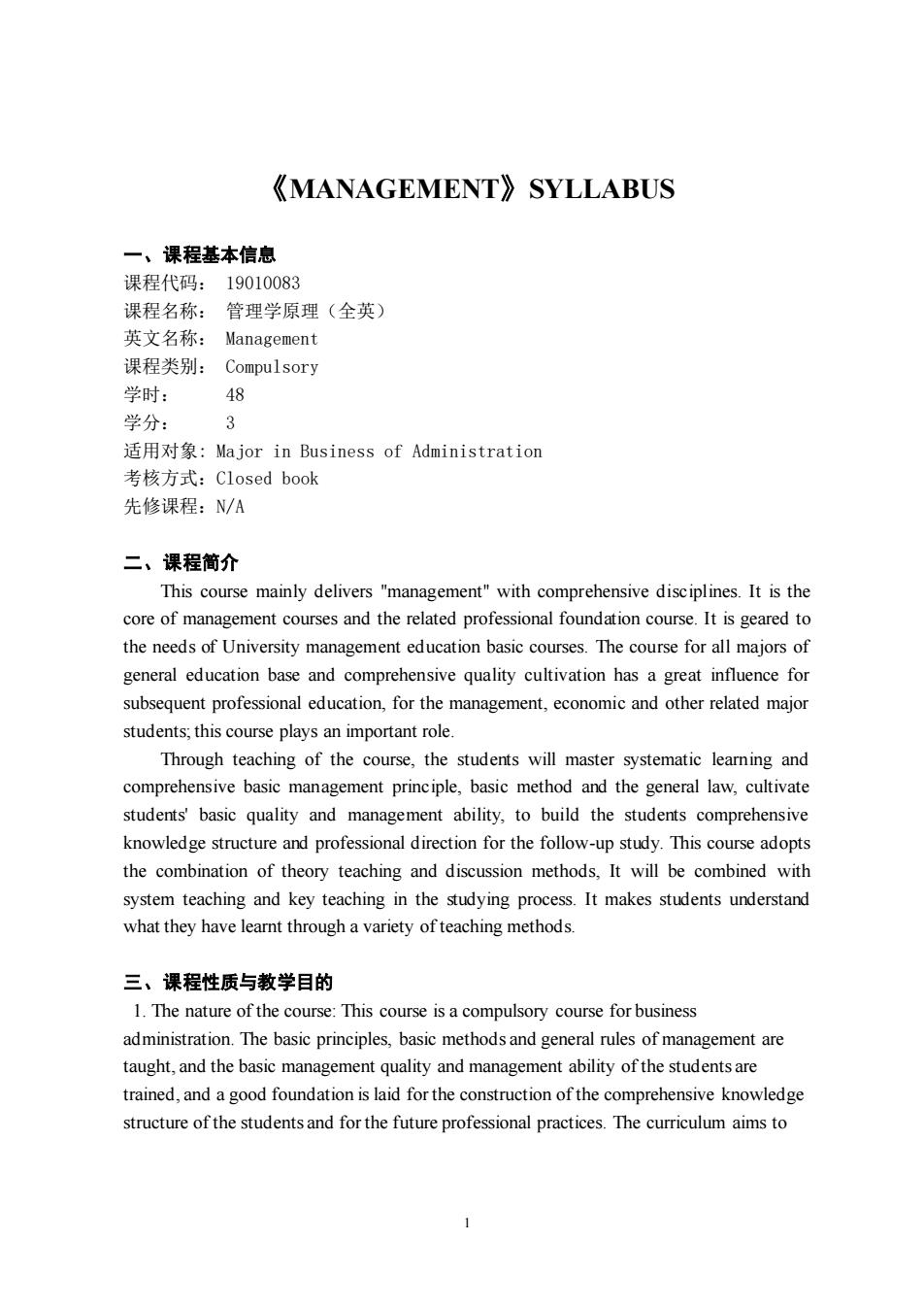
《ANAGEMENT》SYLLABUS 一、课程基本信息 课程代码:19010083 课程名称:管理学原理(全英) 英文名称:Management 课程类别:Compulsory 学时: 48 学分: 3 适用对象:Major in Business of Administration 考核方式:C1 osed book 先修课程:N/A 二、课程简介 This course mainly delivers "management"with comprehensive disciplines.It is the core of management courses and the related professional foundation course.It is geared to the needs of University management education basic courses.The course for all majors of general education base and comprehensive quality cultivation has a great influence for subsequent professional education,for the management,economic and other related major students:this course plays an important role. Through teaching of the course,the students will master systematic leamning and comprehensive basic management principle,basic method and the general law,cultivate students basic quality and management ability,to build the students comprehensive knowledge structure and professional direction for the follow-up study.This course adopts the combination of theory teaching and discussion methods,It will be combined with system teaching and key teaching in the studying process.It makes students understand what they have learnt through a variety ofteaching methods. 三、课程性质与教学目的 1.The nature of the course:This course is a compulsory course for business administration.The basic principles,basic methods and general rules of management are taught,and the basic management quality and management ability of the students are trained,and a good foundation is laid for the construction of the comprehensive knowledge structure of the students and for the future professional practices.The curriculum aims to
1 《MANAGEMENT》SYLLABUS 一、课程基本信息 课程代码: 19010083 课程名称: 管理学原理(全英) 英文名称: Management 课程类别: Compulsory 学时: 48 学分: 3 适用对象: Major in Business of Administration 考核方式:Closed book 先修课程:N/A 二、课程简介 This course mainly delivers "management" with comprehensive disciplines. It is the core of management courses and the related professional foundation course. It is geared to the needs of University management education basic courses. The course for all majors of general education base and comprehensive quality cultivation has a great influence for subsequent professional education, for the management, economic and other related major students; this course plays an important role. Through teaching of the course, the students will master systematic learning and comprehensive basic management principle, basic method and the general law, cultivate students' basic quality and management ability, to build the students comprehensive knowledge structure and professional direction for the follow-up study. This course adopts the combination of theory teaching and discussion methods, It will be combined with system teaching and key teaching in the studying process. It makes students understand what they have learnt through a variety of teaching methods. 三、课程性质与教学目的 1. The nature of the course: This course is a compulsory course for business administration. The basic principles, basic methods and general rules of management are taught, and the basic management quality and management ability of the students are trained, and a good foundation is laid for the construction of the comprehensive knowledge structure of the students and for the future professional practices. The curriculum aims to
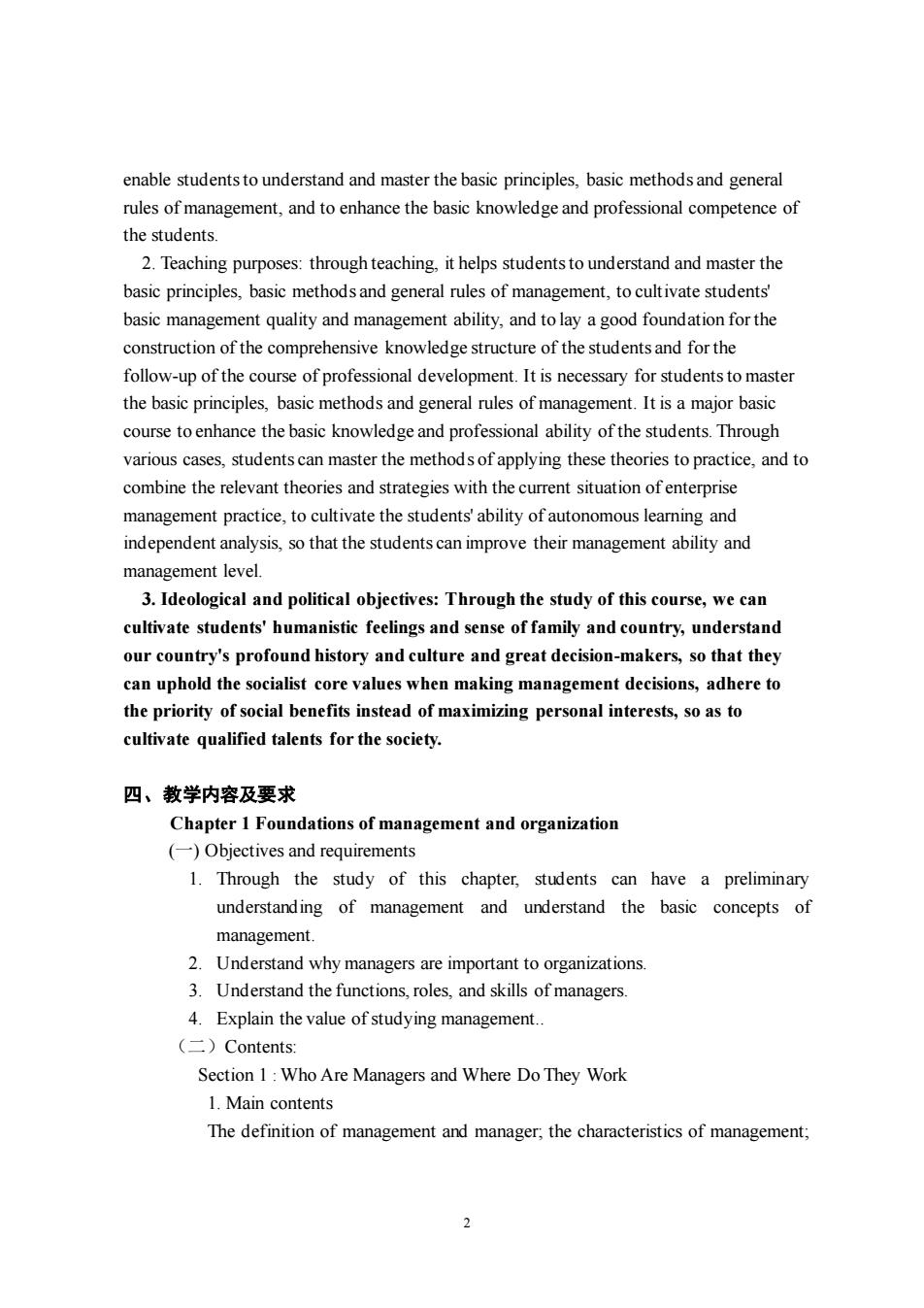
enable students to understand and master the basic principles,basic methods and general rules of management,and to enhance the basic knowledge and professional competence of the students. 2.Teaching purposes:through teaching.it helps studentsto understand and master the basic principles.basic methods and general rules of management.to cultivate students' basic management quality and management ability,and to lay a good foundation for the construction of the comprehensive knowledge structure of the students and for the follow-up of the course of professional development.It is necessary for students to master the basic principles,basic methods and general rules of management.It is a major basic course to enhance the basic knowledge and professional ability of the students.Through various cases,students can master the methods of applying these theories to practice.and to combine the relevant theories and strategies with the current situation of enterprise management practice,to cultivate the students'ability of autonomous learning and independent analysis,so that the students can improve their management ability and management level. 3.Ideological and political objectives:Through the study of this course,we can cultivate students'humanistic feelings and sense of family and country,understand our country's profound history and culture and great decision-makers,so that they can uphold the socialist core values when making management decisions,adhere to the priority of social benefits instead of maximizing personal interests,so as to cultivate qualified talents for the society. 四、教学内容及要求 Chapter 1 Foundations of management and organization (-)Objectives and requirements 1.Through the study of this chapter,students can have a preliminary understarding of management and urderstand the basic conceptsof management. 2.Understand why managers are important to organizations. 3.Understand the functions,roles,and skills of managers. 4.Explain the value of studying management. (二)Contents Section 1:Who Are Managers and Where Do They Work 1.Main contents The definition of management and manager,the characteristics of management; 2
2 enable students to understand and master the basic principles, basic methods and general rules of management, and to enhance the basic knowledge and professional competence of the students. 2. Teaching purposes: through teaching, it helps students to understand and master the basic principles, basic methods and general rules of management, to cultivate students' basic management quality and management ability, and to lay a good foundation for the construction of the comprehensive knowledge structure of the students and for the follow-up of the course of professional development. It is necessary for students to master the basic principles, basic methods and general rules of management. It is a major basic course to enhance the basic knowledge and professional ability of the students. Through various cases, students can master the methods of applying these theories to practice, and to combine the relevant theories and strategies with the current situation of enterprise management practice, to cultivate the students' ability of autonomous learning and independent analysis, so that the students can improve their management ability and management level. 3. Ideological and political objectives: Through the study of this course, we can cultivate students' humanistic feelings and sense of family and country, understand our country's profound history and culture and great decision-makers, so that they can uphold the socialist core values when making management decisions, adhere to the priority of social benefits instead of maximizing personal interests, so as to cultivate qualified talents for the society. 四、教学内容及要求 Chapter 1 Foundations of management and organization (一) Objectives and requirements 1. Through the study of this chapter, students can have a preliminary understanding of management and understand the basic concepts of management. 2. Understand why managers are important to organizations. 3. Understand the functions, roles, and skills of managers. 4. Explain the value of studying management.. (二)Contents: Section 1 : Who Are Managers and Where Do They Work 1. Main contents The definition of management and manager; the characteristics of management;
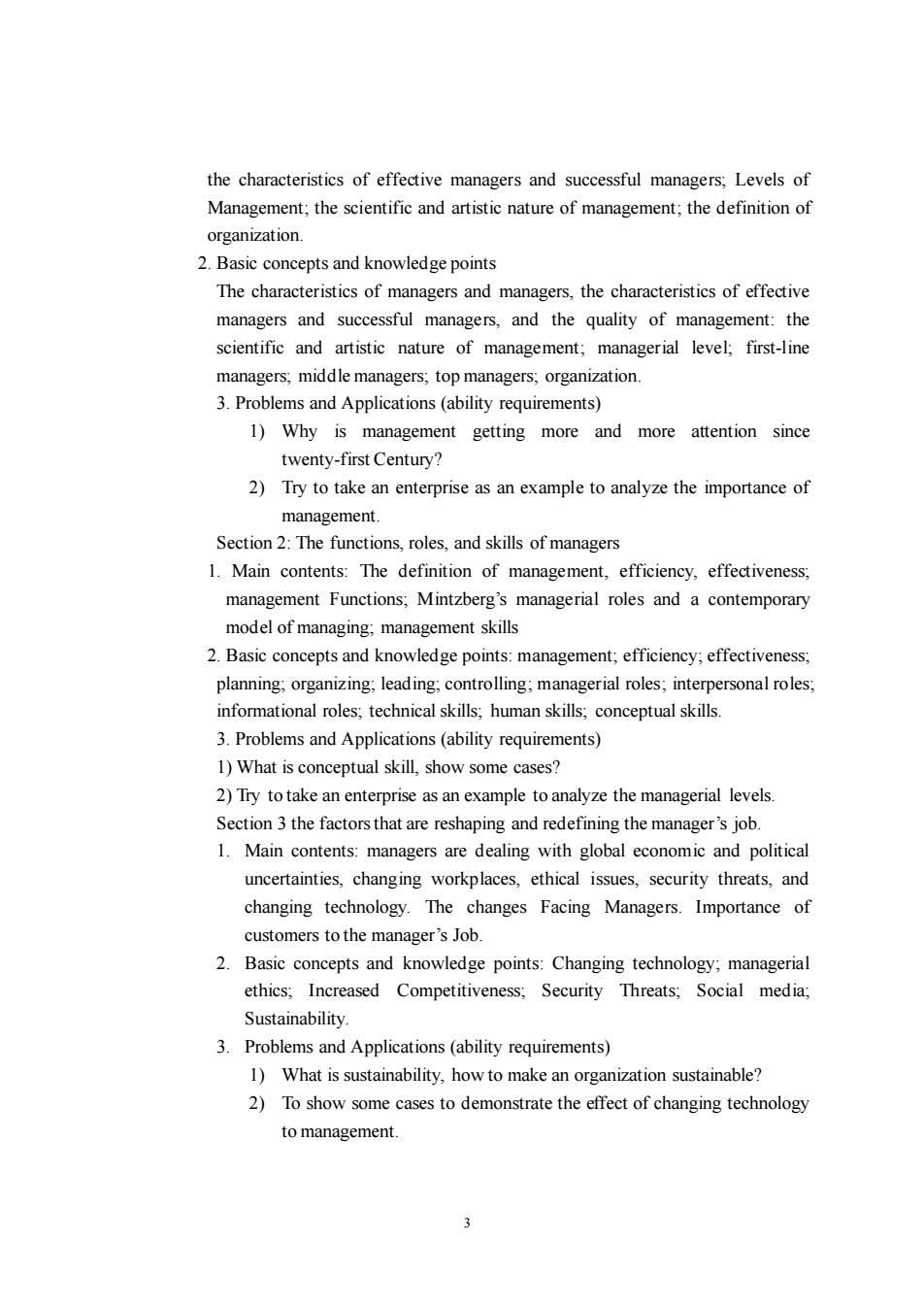
the characteristics of effective managers and successful managers,Levels of Management;the scientific and artistic nature of management;the definition of organization. 2.Basic concepts and knowledge points The characteristics of managers and managers,the characteristics of effective managers and successful managers,and the quality of management:the scientific and artistic nature of management:managerial level:first-line managers,middle managers;top managers;organization. 3.Problems and Applications(ability requirements) 1)Why is management getting more and more attention since twenty-first Century? 2)Try to take an enterprise as an example to analyze the importance of management. Section 2:The functions,roles,and skills of managers 1.Main contents:The definition of management,efficiency,effectiveness, management Functions;Mintzberg's managerial roles and a contemporary model of managing:management skills 2.Basic concepts and knowledge points:management,efficiency,effectiveness, planning,organizing:leading:controlling;managerial roles;interpersonal roles informational roles:technical skills;human skills;conceptual skills. 3.Problems and Applications(ability requirements) 1)What is conceptual skill,show some cases? 2)Try to take an enterprise as an example to analyze the managerial levels Section 3 the factors that are reshaping and redefining the manager's job. 1.Main contents:managers are dealing with global economic and political uncertainties,changing workplaces,ethical issues,security threats,and changing technology.The changes Facing Managers.Importance of customers to the manager's Job. 2.Basic concepts and knowledge points:Changing technology;managerial ethics,Increased Competitiveness;Security Threats;Social media; Sustainability. 3.Problems and Applications(ability requirements) 1)What is sustainability,how to make an organization sustainable? 2)To show some cases to demonstrate the effect of changing technology to management. 3
3 the characteristics of effective managers and successful managers; Levels of Management; the scientific and artistic nature of management; the definition of organization. 2. Basic concepts and knowledge points The characteristics of managers and managers, the characteristics of effective managers and successful managers, and the quality of management: the scientific and artistic nature of management; managerial level; first-line managers; middle managers; top managers; organization. 3. Problems and Applications (ability requirements) 1) Why is management getting more and more attention since twenty-first Century? 2) Try to take an enterprise as an example to analyze the importance of management. Section 2: The functions, roles, and skills of managers 1. Main contents: The definition of management, efficiency, effectiveness; management Functions; Mintzberg’s managerial roles and a contemporary model of managing; management skills 2. Basic concepts and knowledge points: management; efficiency; effectiveness; planning; organizing; leading; controlling; managerial roles; interpersonal roles; informational roles; technical skills; human skills; conceptual skills. 3. Problems and Applications (ability requirements) 1) What is conceptual skill, show some cases? 2) Try to take an enterprise as an example to analyze the managerial levels. Section 3 the factors that are reshaping and redefining the manager’s job. 1. Main contents: managers are dealing with global economic and political uncertainties, changing workplaces, ethical issues, security threats, and changing technology. The changes Facing Managers. Importance of customers to the manager’s Job. 2. Basic concepts and knowledge points: Changing technology; managerial ethics; Increased Competitiveness; Security Threats; Social media; Sustainability. 3. Problems and Applications (ability requirements) 1) What is sustainability, how to make an organization sustainable? 2) To show some cases to demonstrate the effect of changing technology to management
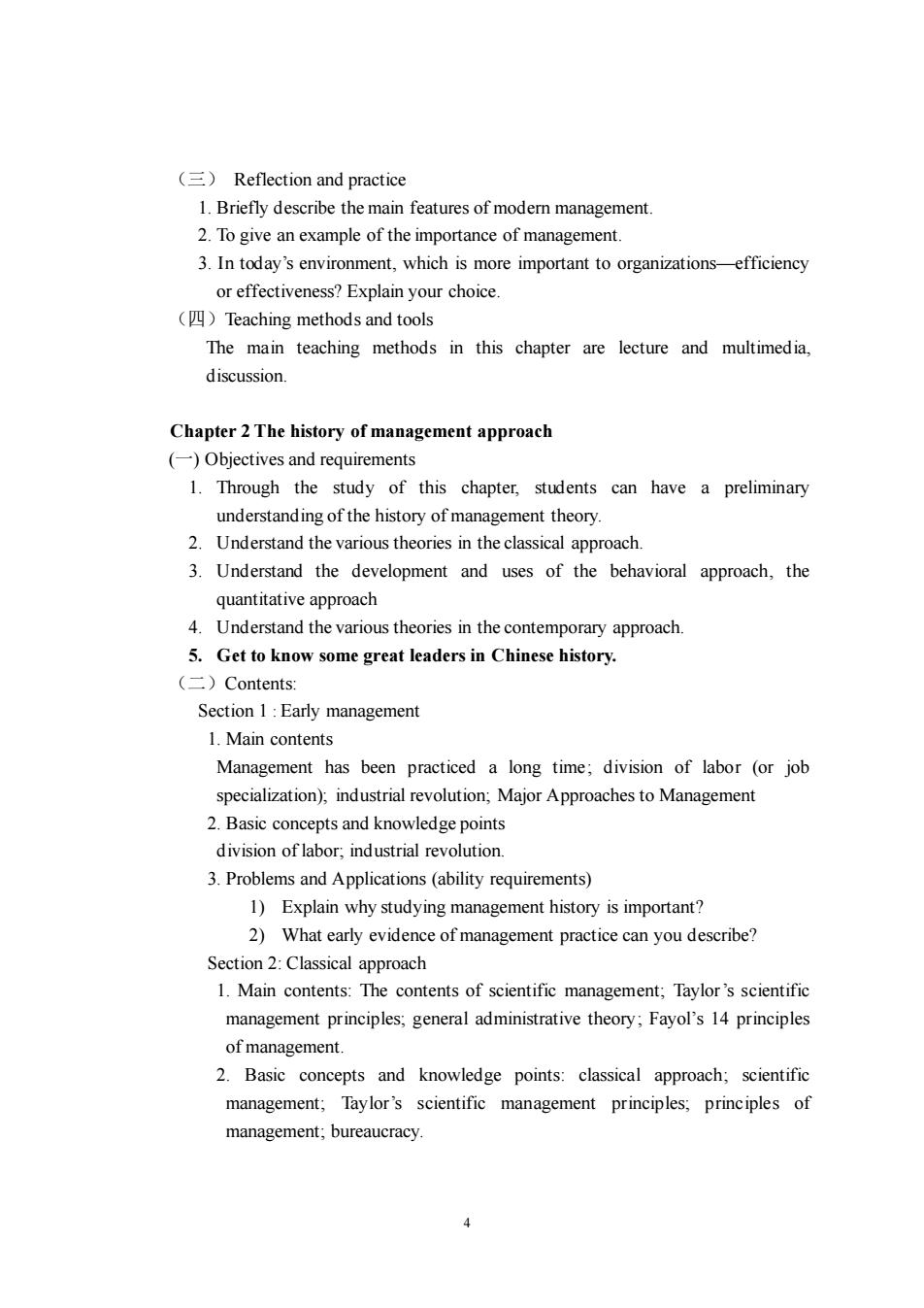
(Reflection and practice 1.Briefly describe the main features of modem management 2.To give an example of the importance of management. 3.In today's environment,which is more important to organizations-efficiency or effectiveness?Explain your choice. Teaching methods and tools The main teaching methods in this chapter are lecture and multimedia, discussion. Chapter 2 The history of management approach (-)Objectives and requirements 1.Through the study of this chapter,students can have a preliminary understanding of the history of management theory. 2.Understand the various theories in the classical approach. 3.Understand the development and uses of the behavioral approach,the quantitative approach 4.Understand the various theories in the contemporary approach 5.Get to know some great leaders in Chinese history. (二)Contents: Section 1:Early management 1.Main contents Management has been practiced a long time;division of labor (or job specialization),industrial revolution;Major Approaches to Management 2.Basic concepts and knowledge points division of labor:industrial revolution 3.Problems and Applications (ability requirements) 1)Explain why studying management history is important? 2)What early evidence of management practice can you describe? Section 2:Classical approach 1.Main contents:The contents of scientific management;Taylor's scientific management principles;general administrative theory:Fayol's 14 principles of management. 2.Basic concepts and knowledge points:classical approach;scientific management:Taylor's scientific management principles;principles of management;bureaucracy. 4
4 (三) Reflection and practice 1. Briefly describe the main features of modern management. 2. To give an example of the importance of management. 3. In today’s environment, which is more important to organizations—efficiency or effectiveness? Explain your choice. (四)Teaching methods and tools The main teaching methods in this chapter are lecture and multimedia, discussion. Chapter 2 The history of management approach (一) Objectives and requirements 1. Through the study of this chapter, students can have a preliminary understanding of the history of management theory. 2. Understand the various theories in the classical approach. 3. Understand the development and uses of the behavioral approach, the quantitative approach 4. Understand the various theories in the contemporary approach. 5. Get to know some great leaders in Chinese history. (二)Contents: Section 1 : Early management 1. Main contents Management has been practiced a long time; division of labor (or job specialization); industrial revolution; Major Approaches to Management 2. Basic concepts and knowledge points division of labor; industrial revolution. 3. Problems and Applications (ability requirements) 1) Explain why studying management history is important? 2) What early evidence of management practice can you describe? Section 2: Classical approach 1. Main contents: The contents of scientific management; Taylor’s scientific management principles; general administrative theory; Fayol’s 14 principles of management. 2. Basic concepts and knowledge points: classical approach; scientific management; Taylor’s scientific management principles; principles of management; bureaucracy
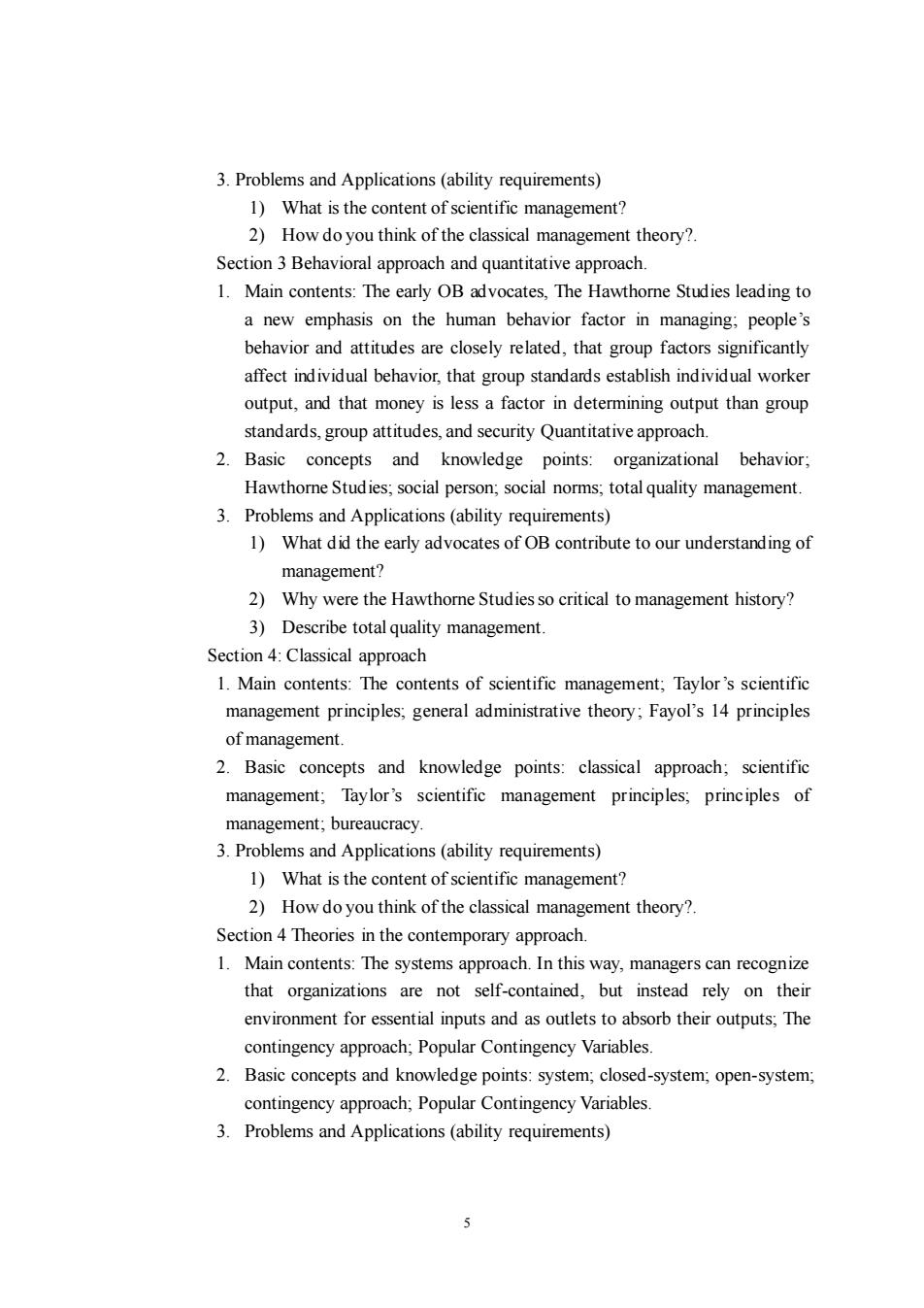
3.Problems and Applications(ability requirements) 1)What is the content of scientific management? 2)How do you think of the classical management theory?. Section 3 Behavioral approach and quantitative approach 1.Main contents:The early OB advocates,The Hawthorne Studies leading to a new emphasis on the human behavior factor in managing;people's behavior and attitudes are closely related,that group factors significantly affect individual behavior,that group standards establish individual worker output,and that money is less a factor in determining output than group standards,group attitudes,and security Quantitative approach. 2.Basic concepts and knowledge points: organizational behavior Hawthorne Studies;social person;social norms,total quality management. 3.Problems and Applications(ability requirements) 1)What did the early advocates of OB contribute to our understanding of management? 2)Why were the Hawthorne Studies so critical to management history? 3)Describe total quality management Section 4:Classical approach 1.Main contents:The contents of scientific management,Taylor's scientific management principles:general administrative theory:Favol's 14 principles of management. 2.Basic concepts and knowledge points:classical approach;scientific management;Taylor's scientific management principles;principles of management;bureaucracy. 3.Problems and Applications(ability requirements) 1)What is the content of scientific management? 2)How do you think of the classical management theory?. Section 4 Theories in the contemporary approach. 1.Main contents:The systems approach.In this way,managers can recognize that organizations are not self-contained,but instead rely on their environment for essential inputs and as outlets to absorb their outputs;The contingency approach;Popular Contingency Variables. 2.Basic concepts and knowledge points:system;closed-system,open-system, contingency approach;Popular Contingency Variables 3.Problems and Applications(ability requirements)
5 3. Problems and Applications (ability requirements) 1) What is the content of scientific management? 2) How do you think of the classical management theory?. Section 3 Behavioral approach and quantitative approach. 1. Main contents: The early OB advocates, The Hawthorne Studies leading to a new emphasis on the human behavior factor in managing; people’s behavior and attitudes are closely related, that group factors significantly affect individual behavior, that group standards establish individual worker output, and that money is less a factor in determining output than group standards, group attitudes, and security Quantitative approach. 2. Basic concepts and knowledge points: organizational behavior; Hawthorne Studies; social person; social norms; total quality management. 3. Problems and Applications (ability requirements) 1) What did the early advocates of OB contribute to our understanding of management? 2) Why were the Hawthorne Studies so critical to management history? 3) Describe total quality management. Section 4: Classical approach 1. Main contents: The contents of scientific management; Taylor’s scientific management principles; general administrative theory; Fayol’s 14 principles of management. 2. Basic concepts and knowledge points: classical approach; scientific management; Taylor’s scientific management principles; principles of management; bureaucracy. 3. Problems and Applications (ability requirements) 1) What is the content of scientific management? 2) How do you think of the classical management theory?. Section 4 Theories in the contemporary approach. 1. Main contents: The systems approach. In this way, managers can recognize that organizations are not self-contained, but instead rely on their environment for essential inputs and as outlets to absorb their outputs; The contingency approach; Popular Contingency Variables. 2. Basic concepts and knowledge points: system; closed-system; open-system; contingency approach; Popular Contingency Variables. 3. Problems and Applications (ability requirements)
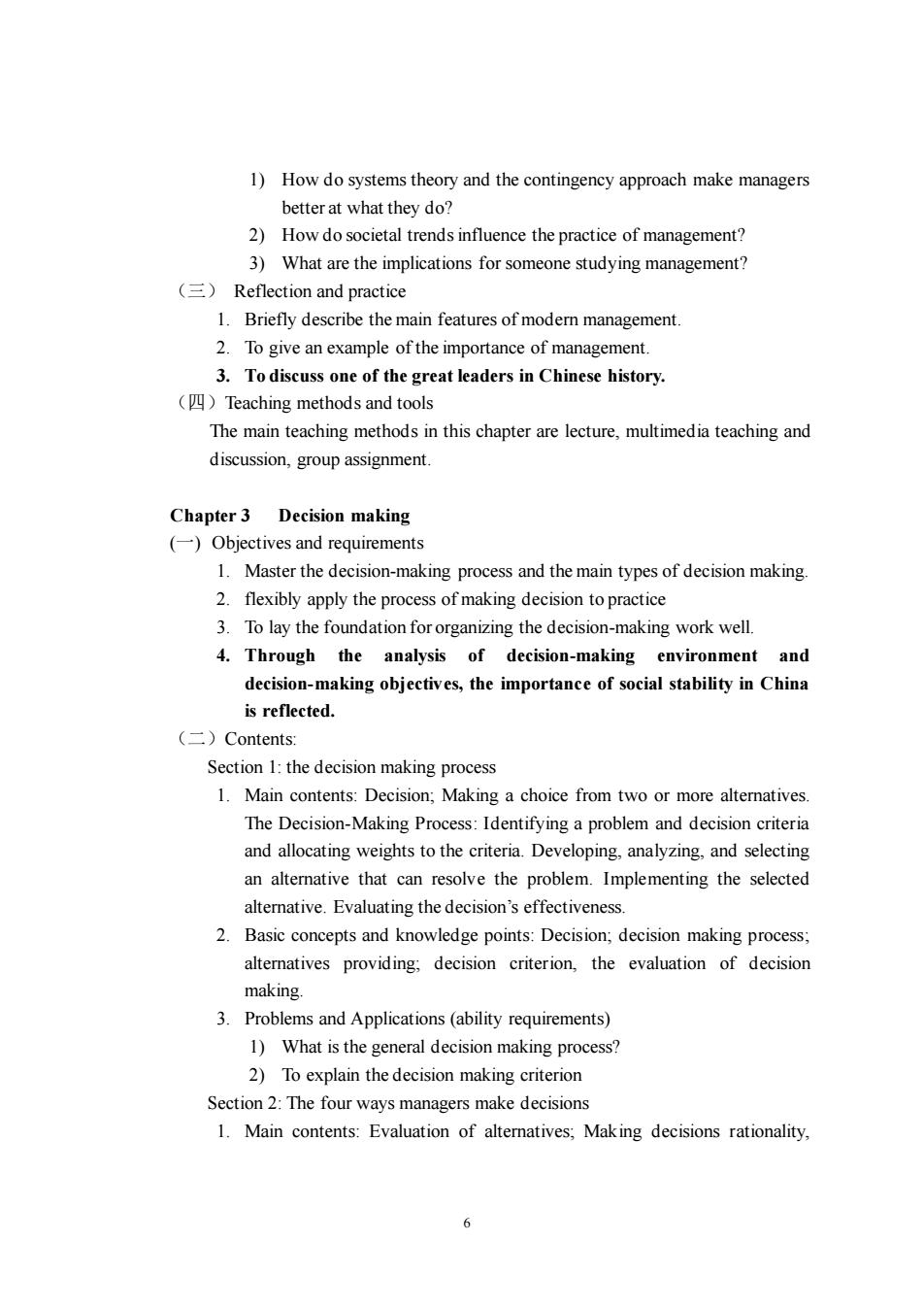
1)How do systems theory and the contingency approach make managers better at what they do? 2)How do societal trends influence the practice of management? 3)What are the implications for someone studying management? ()Reflection and practice 1.Briefly describe the main features of modern management 2.To give an example of the importance of management. 3.To discuss one of the great leaders in Chinese history. (Teaching methods and tools The main teaching methods in this chapter are lecture,multimedia teaching and discussion,group assignment. Chapter 3 Decision making (-)Objectives and requirements 1.Master the decision-making process and the main types of decision making 2.flexibly apply the process of making decision to practice 3.To lay the foundation for organizing the decision-making work well 4.Through the analysis of decision-making environment and decision-making objectives,the importance of social stability in China is reflected. (二)Contents: Section 1:the decision making process 1.Main contents:Decision;Making a choice from two or more alternatives The Decision-Making Process:Identifying a problem and decision criteria and allocating weights to the criteria.Developing.analyzing.and selecting an alternative that can resolve the problem.Implementing the selected altemative.Evaluating the decision's effectiveness. 2.Basic concepts and knowledge points:Decision;decision making process; alternatives providing;decision criterion,the evaluation of decision making. 3.Problems and Applications(ability requirements) 1)What is the general decision making process? 2)To explain the decision making criterion Section 2:The four ways managers make decisions 1.Main contents:Evaluation of alternatives,Making decisions rationality, 6
6 1) How do systems theory and the contingency approach make managers better at what they do? 2) How do societal trends influence the practice of management? 3) What are the implications for someone studying management? (三) Reflection and practice 1. Briefly describe the main features of modern management. 2. To give an example of the importance of management. 3. To discuss one of the great leaders in Chinese history. (四)Teaching methods and tools The main teaching methods in this chapter are lecture, multimedia teaching and discussion, group assignment. Chapter 3 Decision making (一) Objectives and requirements 1. Master the decision-making process and the main types of decision making. 2. flexibly apply the process of making decision to practice 3. To lay the foundation for organizing the decision-making work well. 4. Through the analysis of decision-making environment and decision-making objectives, the importance of social stability in China is reflected. (二)Contents: Section 1: the decision making process 1. Main contents: Decision; Making a choice from two or more alternatives. The Decision-Making Process: Identifying a problem and decision criteria and allocating weights to the criteria. Developing, analyzing, and selecting an alternative that can resolve the problem. Implementing the selected alternative. Evaluating the decision’s effectiveness. 2. Basic concepts and knowledge points: Decision; decision making process; alternatives providing; decision criterion, the evaluation of decision making. 3. Problems and Applications (ability requirements) 1) What is the general decision making process? 2) To explain the decision making criterion Section 2: The four ways managers make decisions 1. Main contents: Evaluation of alternatives; Making decisions rationality

that is make logical and consistent choices to maximize value.Making Decisions:Bounded Rationality;Making Decisions:the Role of Intuition; Making Decisions:the Role of Evidence-Based Management 2.Basic concepts and knowledge points:Rational decision making:Bounded rationality;Satisfice;escalation of commitment;intuitive decision making. evidence-based management 3.Problems and Applications(ability requirements) 1)Compare and contrast the four ways managers make decisions 2)Give examples to illustrate intuitive decision making. Section 3:Tvpes of decisions and decision-making conditions. 1.Main contents:types of Decisions:Decision-making conditions:when making decisions,managers may face three different conditions:certainty, risk;Expected value and uncertainty 2.Basic concepts and knowledge points:structured problems:programmed decision;procedure:rule:policy:unstructured problems:non programmed decisions;certainty;risk;uncertainty 3.Problems and Applications(ability requirements 1)Explain the two types of problems and decisions 2)Contrast the three decision-making conditions 3)Are you a linear or nonlinear thinker,why? Section 4:Decision-making styles and decision biases 1.Main contents:Different decision-making styles and decision making biases will affect manager's decision,linear thinking style is characterized by a person's preference for using external data and facts and processing this information through rational,logical thinking to guide decisions and actions.The second,nonlinear thinking style is characterized by a preference for internal sources of information (feelings and intuition)and processing this information with internal insights,feelings,and hunches to guide decisions and actions affect decision making;Decision-Making Biases and Errors,overview of managerial decision making:guidelines for effective decision making. 2.Basic concepts and knowledge points:linear thinking style:heuristics nonlinear thinking style;overconfidence;Anchoring effect;Sunk costs; design thinking 3.Problems and Applications(ability requirements) 7
7 that is make logical and consistent choices to maximize value. Making Decisions: Bounded Rationality; Making Decisions: the Role of Intuition; Making Decisions: the Role of Evidence-Based Management 2. Basic concepts and knowledge points: Rational decision making; Bounded rationality; Satisfice; escalation of commitment; intuitive decision making; evidence-based management 3. Problems and Applications (ability requirements) 1) Compare and contrast the four ways managers make decisions. 2) Give examples to illustrate intuitive decision making. Section 3: Types of decisions and decision-making conditions. 1. Main contents: types of Decisions; Decision-making conditions: when making decisions, managers may face three different conditions: certainty, risk; Expected value and uncertainty. 2. Basic concepts and knowledge points: structured problems; programmed decision; procedure; rule; policy; unstructured problems; non programmed decisions; certainty; risk; uncertainty. 3. Problems and Applications (ability requirements) 1) Explain the two types of problems and decisions. 2) Contrast the three decision-making conditions. 3) Are you a linear or nonlinear thinker, why? Section 4: Decision-making styles and decision biases. 1. Main contents: Different decision-making styles and decision making biases will affect manager’s decision; linear thinking style is characterized by a person’s preference for using external data and facts and processing this information through rational, logical thinking to guide decisions and actions. The second, nonlinear thinking style is characterized by a preference for internal sources of information (feelings and intuition) and processing this information with internal insights, feelings, and hunches to guide decisions and actions affect decision making; Decision-Making Biases and Errors; overview of managerial decision making; guidelines for effective decision making. 2. Basic concepts and knowledge points: linear thinking style; heuristics; nonlinear thinking style; overconfidence; Anchoring effect; Sunk costs; design thinking; 3. Problems and Applications (ability requirements)
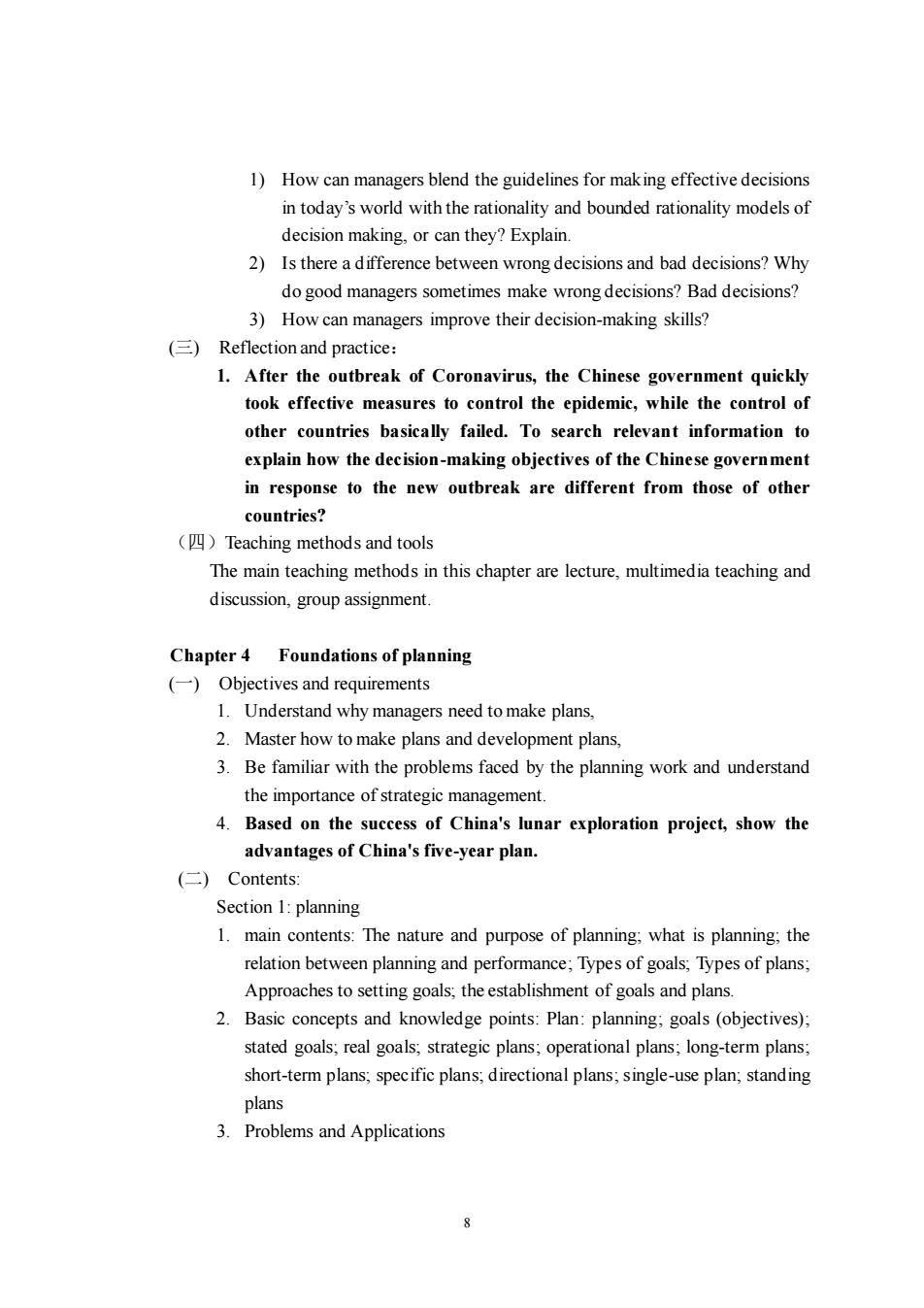
1)How can managers blend the guidelines for making effective decisions in today's world with the rationality and bounded rationality models of decision making,or can they?Explain. 2)Is there a difference between wrong decisions and bad decisions?Why do good managers sometimes make wrong decisions?Bad decisions? 3)How can managers improve their decision-making skills? ()Reflectionand practice: 1.After the outbreak of Coronavirus,the Chinese government quickly took effective measures to control the epidemic,while the control of other countries basically failed.To search relevant information to explain how the decision-making objectives of the Chinese government in response to the new outbreak are different from those of other countries? (Teaching methods and tools The main teaching methods in this chapter are lecture.multimedia teaching and discussion.group assignment. Chapter 4 Foundations of planning (-)Objectives and requirements 1.Understand why managers need to make plans, 2.Master how to make plans and development plans. 3.Be familiar with the problems faced by the planning work and understand the importance of strategic management. 4.Based on the success of China's lunar exploration project,show the advantages of China's five-year plan (仁)Contents: Section1:planning 1.main contents:The nature and purpose of planning;what is planning:the relation between planning and performance;Types of goals,Types of plans; Approaches to setting goals,the establishment of goals and plans. 2.Basic concepts and knowledge points:Plan:planning;goals (objectives); stated goals;real goals,strategic plans:operational plans;long-term plans; short-term plans;specific plans;directional plans;single-use plan;standing plans 3.Problems and Applications 8
8 1) How can managers blend the guidelines for making effective decisions in today’s world with the rationality and bounded rationality models of decision making, or can they? Explain. 2) Is there a difference between wrong decisions and bad decisions? Why do good managers sometimes make wrong decisions? Bad decisions? 3) How can managers improve their decision-making skills? (三) Reflection and practice: 1. After the outbreak of Coronavirus, the Chinese government quickly took effective measures to control the epidemic, while the control of other countries basically failed. To search relevant information to explain how the decision-making objectives of the Chinese government in response to the new outbreak are different from those of other countries? (四)Teaching methods and tools The main teaching methods in this chapter are lecture, multimedia teaching and discussion, group assignment. Chapter 4 Foundations of planning (一) Objectives and requirements 1. Understand why managers need to make plans, 2. Master how to make plans and development plans, 3. Be familiar with the problems faced by the planning work and understand the importance of strategic management. 4. Based on the success of China's lunar exploration project, show the advantages of China's five-year plan. (二) Contents: Section 1: planning 1. main contents: The nature and purpose of planning; what is planning; the relation between planning and performance; Types of goals; Types of plans; Approaches to setting goals; the establishment of goals and plans. 2. Basic concepts and knowledge points: Plan: planning; goals (objectives); stated goals; real goals; strategic plans; operational plans; long-term plans; short-term plans; specific plans; directional plans; single-use plan; standing plans 3. Problems and Applications

1)Compare the benefit oflong-term plan and short-term plan 2)Why are there stated goals and real goals for an organization? Section 2:Setting goals and developing plans 1.main contents:The procedures for setting goals,target management,and planning:Compare and contrast approaches to goal-setting and planning. The downside of traditional goal-setting;management by objectives (MBO).steps in goal-setting:Three contingency factors affect the choice of plans:organizational level,degree of environmental uncertainty,and length of future commitments:Approaches to planning:environmental scanning. 2.Basic concepts and knowledge points:traditional goal-setting;means-ends chain,management by objectives (MBO)mission,commitment concept formal planning department;environmental scanning;competitor intelligence. 3.Problems and Applications 1)Explain the three contingency factorsaffect the choice of plans 2)What is MBO and how to implement this method? (Reflection and practices 1.A brief description of the necessary steps to achieve the goal 2.How to implement target management. 3.Based on the success of China's lunar exploration project,show the advantages of China's five-year plan (Teaching methods and tools The main teaching methods in this chapter are lecture,multimedia teaching and discussion,group assignment. Chapter 5 Foundations oforganizational design (-)Objectives and requirements 1.Understand the definition of organizational structure. 2.Master organizational design decisions and recognize common organizational design. 3.Understand organizational culture and grasp the characteristics of organizational change 4.Understand the importance of innovation management. 5.Based on the organizational innovation of Hair Company,to showcase the strong leadership of Chinese entrepreneurs
9 1) Compare the benefit of long-term plan and short-term plan. 2) Why are there stated goals and real goals for an organization? Section 2: Setting goals and developing plans 1. main contents: The procedures for setting goals, target management, and planning; Compare and contrast approaches to goal-setting and planning; The downside of traditional goal-setting; management by objectives (MBO); steps in goal-setting; Three contingency factors affect the choice of plans: organizational level, degree of environmental uncertainty, and length of future commitments; Approaches to planning; environmental scanning. 2. Basic concepts and knowledge points: traditional goal-setting; means-ends chain; management by objectives (MBO); mission; commitment concept; formal planning department; environmental scanning; competitor intelligence. 3. Problems and Applications 1) Explain the three contingency factors affect the choice of plans. 2) What is MBO and how to implement this method? (三)Reflection and practice: 1. A brief description of the necessary steps to achieve the goal 2. How to implement target management. 3. Based on the success of China's lunar exploration project, show the advantages of China's five-year plan. (四)Teaching methods and tools The main teaching methods in this chapter are lecture, multimedia teaching and discussion, group assignment. Chapter 5 Foundations of organizational design (一) Objectives and requirements 1. Understand the definition of organizational structure, 2. Master organizational design decisions and recognize common organizational design. 3. Understand organizational culture and grasp the characteristics of organizational change. 4. Understand the importance of innovation management. 5. Based on the organizational innovation of Hair Company, to showcase the strong leadership of Chinese entrepreneurs

(二)Contents: Section 1:six key elements in organizational design 1.Main contents:Purposes of organizing;the meaning of Organizational structure:the six key elements that affect organizational design:chain of command;authority theory;span of control;centralization and decentralization;formalization. 2.Basic concepts and knowledge points:organizing:organizational structure: organizational design:work specialization:departmentalization:functional departmentalization; product departmentalization: geographical departmentalization; process departmentalization; customer departmentalization;cross-functional teams:chain of command:authority:. line authority;unity of command;span of control;centralization and decentralization;formalization. 3.Problems and Applications 1)Discuss the traditional and contemporary views of each of the six key elements oforganizational design. 2)Discuss the difference of centralized organization structure and decentralized organization structure. Section 2:organizational structure 1.Main contents:Employee Empowerment;Organizational Design Decisions: Mechanistic Organization structure.Organic Organization structure Contingency Factors Common Organizational Designs:Simple structure, Functional structure,Divisional structure,Team structures,Matrix and project structures,Boundary less Organization Formalization Effective implementation of the objectives identified in the plan and division of departments.allocation of rights and coord ination of work in the organization. 2.Basic concepts and knowledge points:mechanistic organization;organic organization;unit production;mass production;process production;simple structure:functional structure:divisional structure 3.Problems and Applications 1)Contrast mechanistic and organic organizations 2)Would you rather work in a mechanistic or an organic organization? Why? 3)Contrast the three traditional organizational designs. 10
10 (二) Contents: Section 1: six key elements in organizational design 1. Main contents: Purposes of organizing; the meaning of Organizational structure; the six key elements that affect organizational design; chain of command; authority theory; span of control; centralization and decentralization; formalization. 2. Basic concepts and knowledge points: organizing; organizational structure; organizational design; work specialization; departmentalization; functional departmentalization; product departmentalization; geographical departmentalization; process departmentalization; customer departmentalization; cross-functional teams; chain of command; authority; line authority; unity of command; span of control; centralization and decentralization; formalization. 3. Problems and Applications 1) Discuss the traditional and contemporary views of each of the six key elements of organizational design. 2) Discuss the difference of centralized organization structure and decentralized organization structure. Section 2: organizational structure 1. Main contents: Employee Empowerment; Organizational Design Decisions: Mechanistic Organization structure, Organic Organization structure; Contingency Factors Common Organizational Designs: Simple structure, Functional structure, Divisional structure, Team structures, Matrix and project structures, Boundary less Organization Formalization Effective implementation of the objectives identified in the plan and division of departments, allocation of rights and coordination of work in the organization. 2. Basic concepts and knowledge points: mechanistic organization; organic organization; unit production; mass production; process production; simple structure; functional structure; divisional structure. 3. Problems and Applications 1) Contrast mechanistic and organic organizations. 2) Would you rather work in a mechanistic or an organic organization? Why? 3) Contrast the three traditional organizational designs